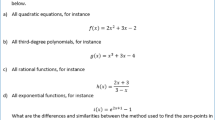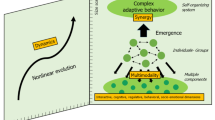Abstract
An increasing number of collaborative learning environments is based on shared workspace systems using two-dimensional graph-structured visual representations such as argumentation networks and concept maps. We propose an integrated framework that allows for flexibly specifying a wide range of visual languages and plugging in components for operational semantics, adequate feedback and intelligent support. The generic application CardBoard provides card-based user interaction and collaboration by means of different languages in shared workspaces. To enhance modifiability, the interfaces between the distributed heterogeneous system components, particularly between intelligent components and user interfaces, have been standardised.
Similar content being viewed by others
References
Aronson, E. (1978). The Jigsaw Classroom. Beverly Hills, CA: Sage.
Bodemer, D. (1998). Direkte und rechnervermittelte kooperative Konstruktion von Begriffsnetzen. (Direct and computer-mediated cooperative construction of concept maps.) Master Thesis, University of Freiburg, Dept. of Cognitive Science.
Buckingham Shum, S., and N. Hammond. (1994). Argumentation-based design rationale: what use at what cost? International Journal Human-Computer Studies, 40, 603–652.
Burton, M., and P. Brna. (1996). Clarissa: An exploration of collaboration through agent-based dialogue games. In Proceedings of the European Conference on Artificial Intelligence in Education (pp. 393-400). Lisbon (Portugal), September/October 1996.
Hoppe, H. U. (1995). Using multiple student modeling to parameterize group learning. In Proceedings of the 7th World Conference on Artificial Intelligence in Education (pp. 234–241). Charlottesville (VA): AACE.
Hoppe, H. U., N. Baloian, and J. Zhao. (1993). Computer support for teacher-centered classroom interaction. In Proceedings of the International Conference on Computers in Education (pp. 211-217). Taipei (Taiwan), December 1993.
Lakin, F. (1990). Visual languages for co-operation: A performing medium approach to systems for cooperative work. In: J. Galegher, R. Kraut, and C. Egido (eds.), Intellectual Teamwork. Hillsdale NJ: Lawrence Erlbaum Associates. (pp. 453–488).
Mühlenbrock, M., F. Tewissen, and H. U. Hoppe. (1997). A framework system for intelligent support in open distributed learning environments. In Proceedings of the 8th World Conference on Artificial Intelligence in Education (pp. 191-198). Kobe (Japan), August 1997.
Mühlenbrock, M., H. U. Hoppe. (1998). Constructive and collaborative learning environments: What functions are left for user modelling and intelligent support? In Bredeweg, Bert. Model-based Reasoning for Intelligent Education Environments, International workshop at the European Conference of Artificial Intelligence ECAI-98.
Novak, J. D. (1990). Concept mapping: A useful tol for science education. Journal of Research in Science Teaching, 27, 937–949.
Paiva, A. (1997). Learner modelling for collaborative learning environments. In Proceedings of the 8th World Conference on Artificial Intelligence in Education (pp. 215-222). Kobe (Japan), August 1997.
Plötzner, R., H. U. Hoppe, E. Fehse, C. Nolte, and F. Tewissen. (1996). Model-based design of activity spaces for collaborative problem solving and learning. In Proceedings of the European Conference on Artificial Intelligence in Education (p. 372-378). Lisbon (Portgual).
Ritter, S., and K. R. Koedinger. (1996). An architecture for plug-in tutor agents. Journal of Artificial Intelligence in Education, 7 (3/4), 315–347.
Stefik, M., D. G. Bobrow, K. Kahn, S. Lanning, and L. Suchman. (1987). Beyond the chalkboard: Computer support for collaboration and problem solving in meetings. Communications of the ACM, 30 (1), 32–47.
Streitz, N. A., J. Geißler, J. M. Haake, and J. Hol. (1994). DOLPHIN: Integrated meeting support across liveboards, local and remoe desktop environments. In Proceedings of ACM Conference on Computer-Supported Co-operative Work (pp. 345-358). Chapel Hill (North Carolina), October 1994.
Suthers, D., A. Weiner, J. Connelly, and M. Paolucci. (1995). Belvedere: Engaging students in critical discussion of science and public policy issues. In Proceedings of the 7th World Conference on Artificial Intelligence in Education (pp. 266–273). Charlottesvile (VA): AACE.
Suthers, D., and D. Jones. (1997). An architecture for intelligent collaborative educational systems. In Proceedings of the 8th World Conference on Artificial Intelligence in Education (pp. 55-62). Kobe (Japan), August 1997.
Tewissen, F. (1996). Begriffsnetze als Basis für ein System zur kooperativen Lösung physikalischer Aufgabentellungen. (Concept maps as a basis for a system supporting the co-operative solution of physics problems). Master Thesis, University of Duisburg, Dept. of Mathematics/Computer Science.
Zhao, J., and H. U. Hoope. (1995). Getting serious about flexible user interface coupling. In Proceedings of the International Workshop on the Design of Co-operative Systems. Juanles-Pins (France), January 1995.
Author information
Authors and Affiliations
Rights and permissions
About this article
Cite this article
Hoppe, H.U., Gaßner, K., Muuml;hlenbrock, M. et al. Distributed Visual Language Environments for Cooperation and Learning: Applications and Intelligent Support. Group Decision and Negotiation 9, 205–220 (2000). https://doi.org/10.1023/A:1008735223451
Issue Date:
DOI: https://doi.org/10.1023/A:1008735223451




